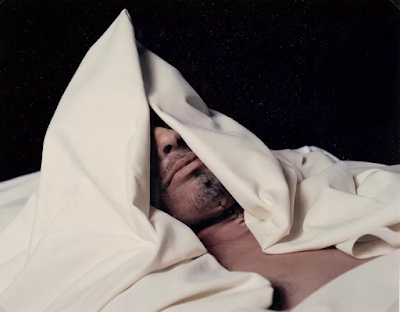In this post I will be researching about various artists for my conceptualization of my traces.
Photography has long been regarded as a medium of memory and nostalgia. However, as the French philosopher Jacques Derrida suggests, photography can also be seen as a "trace" of something that has passed. This "trace" can take many forms, from the physical marks left on the surface of a photograph to the psychological imprints of the past on the viewer's mind.
Firstly, we will examine the work of Sally Mann, an American photographer known for her black and white images of the American South. In her series "Immediate Family," Mann documents the lives of her three children in a way that is both intimate and unsettling. Her images are marked by a sense of nostalgia, but they also contain traces of pain and vulnerability. The scratches and stains on the surface of the photographs, as well as the way the subjects are posed, suggest a sense of impermanence and mortality. Mann's photographs are not simply memories of the past, but rather traces of a specific moment in time.
Secondly, we will turn to the work of Elinor Carucci, an Israeli photographer based in New York City. In her series "Mother," Carucci documents the joys and struggles of motherhood through intimate images of herself and her family. Carucci's photographs are marked by a sense of vulnerability and raw emotion. The physical traces of motherhood - stretch marks, scars, and other imperfections - are visible on her body, and this physicality is echoed in the way she photographs her subjects. Carucci's images are not simply memories of a specific time and place, but rather traces of the lived experience of motherhood.
Finally, we will look at the work of Andres Serrano, an American photographer best known for his controversial images of bodily fluids and waste. In his series "The Morgue," Serrano documents the aftermath of violent death in a way that is both shocking and strangely beautiful. The photographs are marked by a sense of detachment and objectivity, but also contain traces of empathy and humanity. The physical traces of violence - blood, bruises, and other wounds - are captured in great detail, but so too are the subtle traces of the lives that were lost. Serrano's images are not simply records of a violent act, but rather traces of the human experience of death.
Ultimately, the concept of traces in photography offers a rich and nuanced way of understanding the medium. Through the works of selected artists, we have seen how traces can take many forms - from physical marks on the surface of a photograph to psychological imprints on the viewer's mind. By exploring these traces, we gain a deeper understanding of the past and the present, and of the complex ways in which photography can capture the fleeting moments of our lives.
References:
Bate, D. (2009). Photography: The key concepts. Bloomsbury Publishing.
Benjamin, W. (1936). The work of art in the age of mechanical reproduction. Zeitschrift für Sozialforschung, 5(1), 40-68.
Berger, J. (1972). Ways of seeing. Penguin Books.
Cotton, C. (2014). The photograph as contemporary art. Thames & Hudson.
Fontcuberta, J. (2014). The photography of nature and the nature of photography. Blume.
Sontag, S. (1977). On photography. Penguin Books.



No comments:
Post a Comment